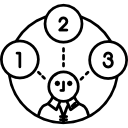Resource management
This is one of the most important ideas you can take with you:
Decompose a problem into smaller parts, model a problem with flowcharts. Learn to think sequentially

Computational Thinking (CT) is a process that generalizes a solution to open-ended problems. Open-ended problems encourage full, meaningful answers based on multiple variables, which require using decomposition, data representation, generalization, modeling, and algorithms found in Computational Thinking. Computational Thinking requires the decomposition of the entire decision making process, the variables involved, and all possible solutions, ensuring that the right decision is made based on the corresponding parameters and limitations of the problem. The term computational thinking was first used by Seymour Papert in 1980[1] and again in 1996.[2] Computational thinking can be used to algorithmically solve complicated problems of scale, and is often used to realize large improvements in efficiency[2]